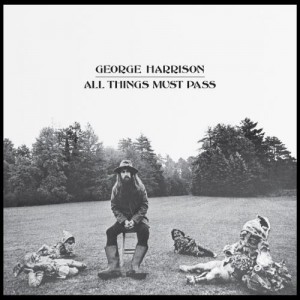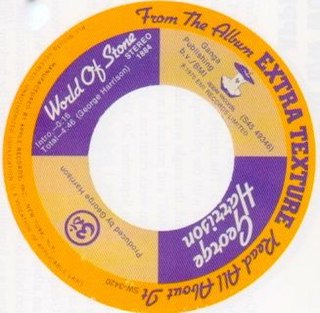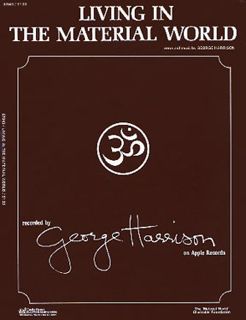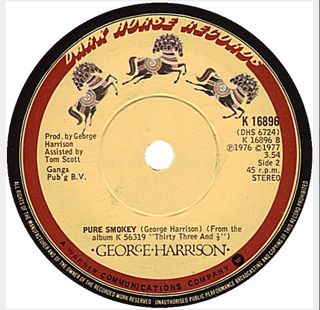
All Things Must Pass is the third studio album by English rock musician George Harrison. Released as a triple album in November 1970, it was Harrison's first solo work after the break-up of the Beatles in April that year. It includes the hit singles "My Sweet Lord" and "What Is Life", as well as songs such as "Isn't It a Pity" and the title track that had been overlooked for inclusion on releases by the Beatles. The album reflects the influence of Harrison's musical activities with artists such as Bob Dylan, the Band, Delaney & Bonnie and Friends and Billy Preston during 1968–70, and his growth as an artist beyond his supporting role to former bandmates John Lennon and Paul McCartney. All Things Must Pass introduced Harrison's signature slide guitar sound and the spiritual themes present throughout his subsequent solo work. The original vinyl release consisted of two LPs of songs and a third disc of informal jams titled Apple Jam. Several commentators interpret Barry Feinstein's album cover photo, showing Harrison surrounded by four garden gnomes, as a statement on his independence from the Beatles.

The discography of English singer-songwriter and former member of the Beatles, George Harrison consists of 12 studio albums, two live albums, four compilation albums, 35 singles, two video albums and four box sets. Harrison's first solo releases – the Wonderwall Music film soundtrack (1968) and Electronic Sound (1969) – were almost entirely instrumental works, issued during the last two years of the Beatles' career. Following the band's break-up in April 1970, Harrison continued to produce recordings by his fellow Apple Records acts, notably former bandmate Ringo Starr. He recorded and collaborated with a wide range of artists, including Shankar, Bob Dylan, Eric Clapton and Gary Wright.

"All Things Must Pass" is a song by English rock musician George Harrison, issued in November 1970 as the title track to his triple album of the same name. Billy Preston released the song originally – as "All Things (Must) Pass" – on his Apple Records album Encouraging Words (1970) after the Beatles had rehearsed the song in January 1969 but did not include it on their Let It Be album. The composition reflects the influence of the Band's sound and communal music-making on Harrison, after he had spent time with the group in Woodstock, New York, in late 1968. In his lyrics, Harrison drew inspiration from Timothy Leary's poem "All Things Pass", a psychedelic adaptation of the Tao Te Ching.

"Dark Horse" is a song by English rock musician George Harrison and the title track to his 1974 solo album on Apple Records. The song was the album's lead single in North America, becoming a top-20 hit in the United States, but it was Harrison's first single not to chart in Britain when issued there in February 1975. The term "dark horse" had long been applied to Harrison due to his unexpected emergence as the most accomplished solo artist of the four former Beatles following the band's break-up in 1970. In the song, however, he said he used the phrase in reference to gossip about someone who carries out clandestine sexual relationships. Commentators interpret the lyrics as a rebuttal to several possible detractors: Harrison's first wife, Pattie Boyd; reviewers who criticised the spiritual content of his 1973 album Living in the Material World; and his former bandmates John Lennon and Paul McCartney. Harrison named his Dark Horse record label after the song, and his 1974 North American tour with Ravi Shankar came to be known as the Dark Horse Tour.

"World of Stone" is a song by English rock musician George Harrison, released in 1975 on Extra Texture , his final album for Apple Records. It was also issued as the B-side of the album's lead single, "You". Harrison wrote the song in 1973 but recorded it two years later, following the unfavourable critical reception afforded his 1974 North American tour with Ravi Shankar and the Dark Horse album. Due to its context on release, commentators view "World of Stone" as a plea from Harrison for tolerance from these detractors. According to some of his biographers, the lyrics reflect Harrison's doubts regarding his devotion to a spiritual path – an apparent crisis of faith that followed his often-unwelcome spiritual pronouncements during the tour, and which permeated his work throughout 1975.
"That's the Way It Goes" is a song by English musician George Harrison from his 1982 album Gone Troppo. Harrison wrote the song during a period when he had become uninterested in contemporary music and was enjoying success as a film producer with his company HandMade Films. Partly influenced by his extended holidays in Hawaii and Australia, the lyrics convey his dismay at the world's preoccupation with money and status, although, unlike several of Harrison's previous musical statements on the subject, he expresses resignation and acceptance.
"Sunshine Life for Me (Sail Away Raymond)" is a song by English musician Ringo Starr from his 1973 album Ringo. It was written by George Harrison, Starr's former bandmate in the Beatles, and was one of several contributions Harrison made to Ringo. Recording for the song took place in Los Angeles in March 1973, with Richard Perry as producer. In addition to Starr and Harrison, the musicians on the track include Levon Helm, Robbie Robertson, Rick Danko and Garth Hudson of the Band, and multi-instrumentalist David Bromberg.

"Ballad of Sir Frankie Crisp (Let It Roll)" is a song by English rock musician George Harrison from his 1970 triple album All Things Must Pass. Harrison wrote the song as a tribute to Frank Crisp, a nineteenth-century lawyer and the original owner of Friar Park – the Victorian Gothic residence in Henley-on-Thames, Oxfordshire, that Harrison purchased in early 1970. Commentators have likened the song to a cinematic journey through the grand house and the grounds of the estate.
"Awaiting on You All" is a song by English musician George Harrison, released on his 1970 triple album, All Things Must Pass. Along with the single "My Sweet Lord", it is among the more overtly religious compositions on All Things Must Pass, and the recording typifies co-producer Phil Spector's influence on the album, due to his liberal use of reverberation and other Wall of Sound production techniques. Harrison recorded the track in London backed by musicians such as Eric Clapton, Bobby Whitlock, Klaus Voormann, Jim Gordon and Jim Price – many of whom he had toured with, as Delaney & Bonnie and Friends, in December 1969, while still officially a member of the Beatles. Musically, the composition reflects Harrison's embracing of the gospel music genre, following his production of fellow Apple Records artists Billy Preston and Doris Troy.

"Living in the Material World" is a song by English rock musician George Harrison that was released as the title track of his 1973 album. In the song's lyrics, Harrison contrasts the world of material concerns with his commitment to a spiritual path, and the conflict is further represented in the musical arrangement as the rock accompaniment alternates with sections of Indian sounds. Inspired by Gaudiya Vaishnava teacher A.C. Bhaktivedanta Swami Prabhupada, the song promotes the need to recognise the illusory nature of human existence and escape the constant cycle of reincarnation, and thereby attain moksha in the Hindu faith. The contrasts presented in "Living in the Material World" inspired the Last Supper-style photograph by Ken Marcus that appeared inside the album's gatefold cover, and also designer Tom Wilkes's incorporation of Krishna-related symbolism elsewhere in the packaging.

"Deep Blue" is a song by English rock musician George Harrison that was released as the B-side to his 1971 charity single "Bangla Desh". Harrison wrote the song in 1970, midway through the recording sessions for All Things Must Pass, and recorded it in Los Angeles the following year while organising the Concert for Bangladesh. The composition was inspired by the deteriorating condition of his mother, Louise, before she succumbed to cancer in July 1970, and by Harrison's feelings of helplessness as he visited her in hospital in the north of England. Given the subject matter, "Deep Blue" also served to convey the suffering endured by the millions of refugees from war-torn Bangladesh in 1971, as sickness and disease became widespread among their makeshift camps in northern India.

"Pure Smokey" is a song by English musician George Harrison, released in 1976 on his debut album for Dark Horse Records, Thirty Three & 1/3. The song was the second of Harrison's musical tributes to American soul singer Smokey Robinson, following "Ooh Baby " in 1975. Harrison frequently cited Robinson as one of his favourite vocalists and songwriters, and Robinson's group the Miracles had similarly influenced the Beatles during the 1960s. In the lyrics to "Pure Smokey", Harrison gives thanks for the gift of Robinson's music, while making a statement regarding the importance of expressing appreciation and gratitude, rather than forgetting to do so and later regretting it. The song title came from the name of Robinson's 1974 album Pure Smokey.

"Your Love Is Forever" is a song by English rock musician George Harrison from his 1979 album George Harrison. He wrote it as a guitar instrumental in an open tuning, before adding lyrics at the suggestion of his co-producer, Russ Titelman. The lyrics have an ambiguity typical of Harrison's work, in that the love he expresses is directed towards both a romantic partner and his God. In the United Kingdom, the song was also issued as the B-side of "Faster", on a charity single benefiting the cancer research project set up by the late Formula 1 driver Gunnar Nilsson.

"Soft Touch" is a song by English rock musician George Harrison from his 1979 album George Harrison. It was also issued as the B-side of the album's lead single, "Blow Away", in Britain and some other countries, while in markets such as North America, it was the B-side of the second single, "Love Comes to Everyone". Harrison wrote the song while in the Virgin Islands with his future wife, Olivia Arias, shortly before recording his 1976 album Thirty Three & ⅓. The song is a love song in which Harrison also conveys his wonder at the idyllic island setting.

"Save the World" is a song by English rock musician George Harrison, released as the final track of his 1981 album Somewhere in England. It was also the B-side of "Teardrops", which was the second single off the album. An environmental protest song, "Save the World" was Harrison's first composition to directly address topical issues such as the nuclear arms race, rainforest and wildlife devastation, and the ecologically irresponsible practices of corporate concerns. Musically, the song partly recalls the style of the comedy troupe Monty Python.
"You and Me (Babe)" is a song by English musician Ringo Starr, released as the final track on his 1973 album Ringo. Starr's fellow ex-Beatle George Harrison wrote the song along with Mal Evans, the Beatles' longtime aide and a personal assistant to Starr during the making of Ringo. The track serves as a farewell from Starr to his audience in the manner of a show-closing finale, by lyrically referring to the completion of the album. During the extended fadeout, Starr delivers a spoken message in which he thanks the musicians and studio personnel who helped with the recording of Ringo – among them, Harrison, John Lennon and Paul McCartney, and his producer, Richard Perry.

"Apple Scruffs" is a song by English rock musician George Harrison from his 1970 triple album All Things Must Pass. He wrote it as a tribute to the die-hard Beatles fans known as Apple scruffs, who used to wait outside the Apple Corps building and other London locations for a glimpse of the band members. This tradition continued after the group's break-up in April 1970, as the scruffs were a regular presence outside the studios where Harrison recorded his album. The song was also issued on the album's second single, as the B-side to "What Is Life".

"I Don't Care Anymore" is a song by English musician George Harrison, released as the B-side of the lead single from his 1974 album Dark Horse. The A-side was "Dark Horse" in the majority of countries internationally and "Ding Dong, Ding Dong" elsewhere, including the United Kingdom. It is one of Harrison's relatively rare compositions in the country music genre and, equally unusual among his 1970s releases, the recording is a solo performance.

Songs by George Harrison is a book of song lyrics and commentary by English musician George Harrison, with illustrations by New Zealand artist Keith West. It was published in February 1988, in a limited run of 2500 copies, by Genesis Publications, and included an EP of rare or previously unreleased Harrison recordings. Intended as a luxury item, each copy was hand-bound and boxed, and available only by direct order through Genesis in England. The book contains the lyrics to 60 Harrison compositions, the themes of which West represents visually with watercolour paintings. Starting in 1985, Harrison and West worked on the project for two years, during which Harrison returned to music-making with his album Cloud Nine, after focusing on film production for much of the early 1980s. The book includes a foreword by his Cloud Nine co-producer, Jeff Lynne, and a written contribution from Elton John.
Songs by George Harrison 2 is a book of song lyrics and commentary by English musician George Harrison, with illustrations by Keith West and an accompanying EP of previously unreleased Harrison recordings. It was published in June 1992, in a limited run of 2500 copies, by Genesis Publications. As with Harrison and West's first volume, published in 1988, each copy was hand-bound and available only by direct order through Genesis in England.
















